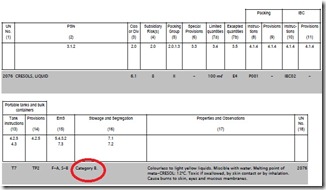Positioning of dangerous goods containers on board vessels are categorised by ‘stowage categories’ to ensure safety. Many points are considered by IMDG Code for safe carriage of dangerous goods by sea-going vessels.

On ships there are two different types of stowage (1) On deck and (2) Under Deck. When we look at a container vessel all those containers we see outside are stowed on deck. The containers stowed below the hatch covers are under-deck stowed units.
For other than class 1 ( explosives ) ships are divided into two groups for this purpose
1) cargo ships or passenger ships carrying a number of passengers limited to not more than 25 or to 1 passenger per 3 m of overall length, whichever is the greater number;
2) other passenger ships in which the limiting number of passengers transported is
exceeded.
For every dangerous goods listed in IMDG Code Dangerous Goods List column 16 specifies stowage requirement. This is indicated by Category A, B , C, D or E.
On Deck only stowage is always prescribed for cases where:
.1 constant supervision is required; or
.2 accessibility is particularly required; or
.3 there is a substantial risk of formation of explosive gas mixtures, development of
highly toxic vapours, or unobserved corrosion of the ship
Below is the entry for UN 2076 Class 6.1 CRESOLS, LIQUID, you can see in column 16 it is written Category B. Substances, Materials or Articles assigned with stowage Category B can be loaded on deck or under deck on a cargo ship but on a passenger ship where limitng number of passengers are exceeded Category B must be loaded on deck only!
Stowage Categories for Goods other than Class 1 (Explosives)
| Stowage category A | |
| Cargo ships or passenger ships carrying a number of Passengers limited to not more than 25 or to 1 passenger per 3 m of overall length, whichever is the greater number | ON DECK OR UNDER DECK |
| Other passenger ships in which the limiting number of passengers transported is exceeded | ON DECK OR UNDER DECK |
| Stowage category B | |
| Cargo ships or passenger ships carrying a number of passengers limited to not more than 25 or to 1 passenger per 3 m of overall length, whichever is the greater number | ON DECK OR UNDER DECK |
| Other passenger ships in which the limiting number of passengers transported is exceeded | ON DECK ONLY |
| Stowage category C | |
| Cargo ships or passenger ships carrying a number of passengers limited to not more than 25 or to 1 passenger per 3 m of overall length, whichever is the greater number | ON DECK ONLY |
| Other passenger ships in which the limiting number of passengers transported is exceeded | ON DECK ONLY |
| Stowage category D | |
| Cargo ships or passenger ships carrying a number of passengers limited to not more than 25 or to 1 passenger per 3 m of overall length, whichever is the greater number | ON DECK ONLY |
| Other passenger ships in which the limiting number of passengers transported is exceeded | PROHIBITED |
| Stowage category E | |
| Cargo ships or passenger ships carrying a number of passengers limited to not more than 25 or to 1 passenger per 3 m of overall length, whichever is the greater number | ON DECK OR UNDER DECK |
| Other passenger ships in which the limiting number of passengers transported is exceeded | PROHIBITED |
You may refer IMDG Code 35th Amendment Chapter 7.1 for full details of stowage requirements including those for Class 1 ( Explosives ).


 WhatsApp your queries
WhatsApp your queries